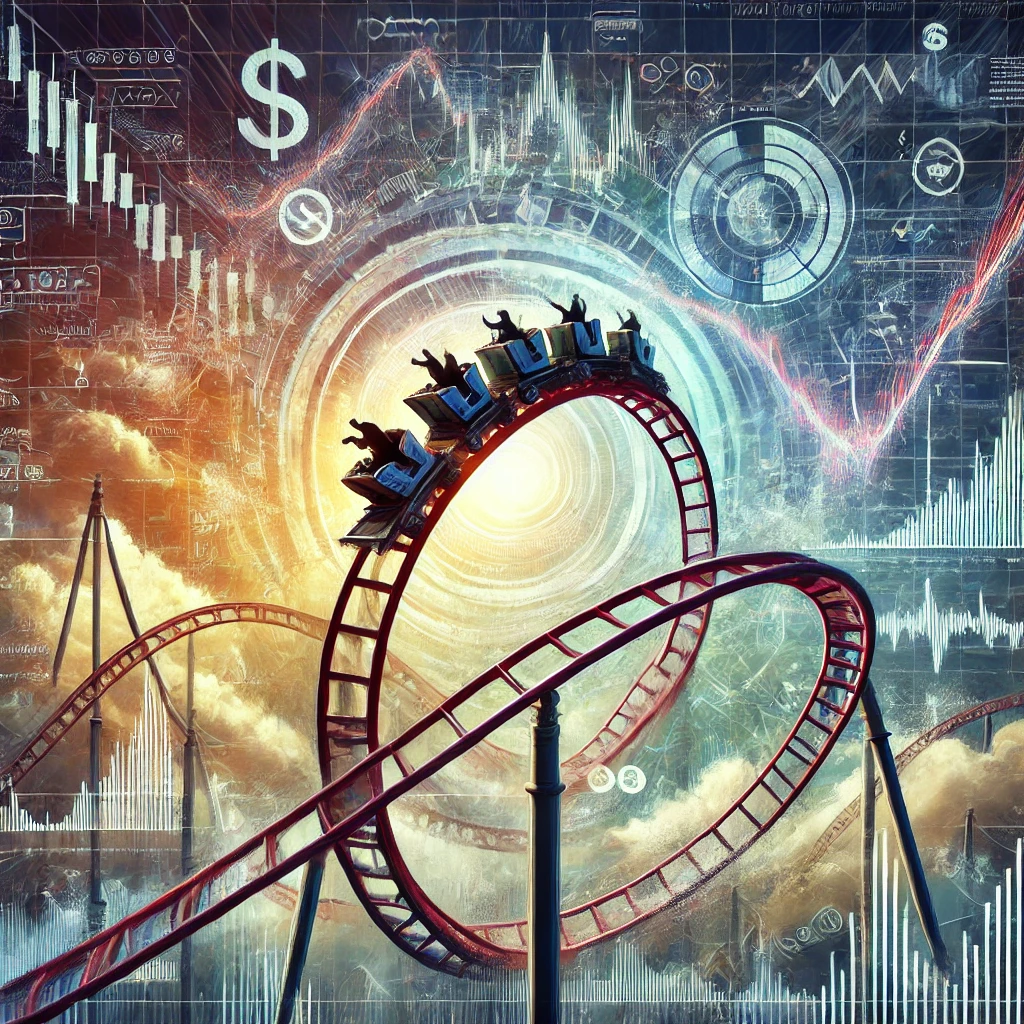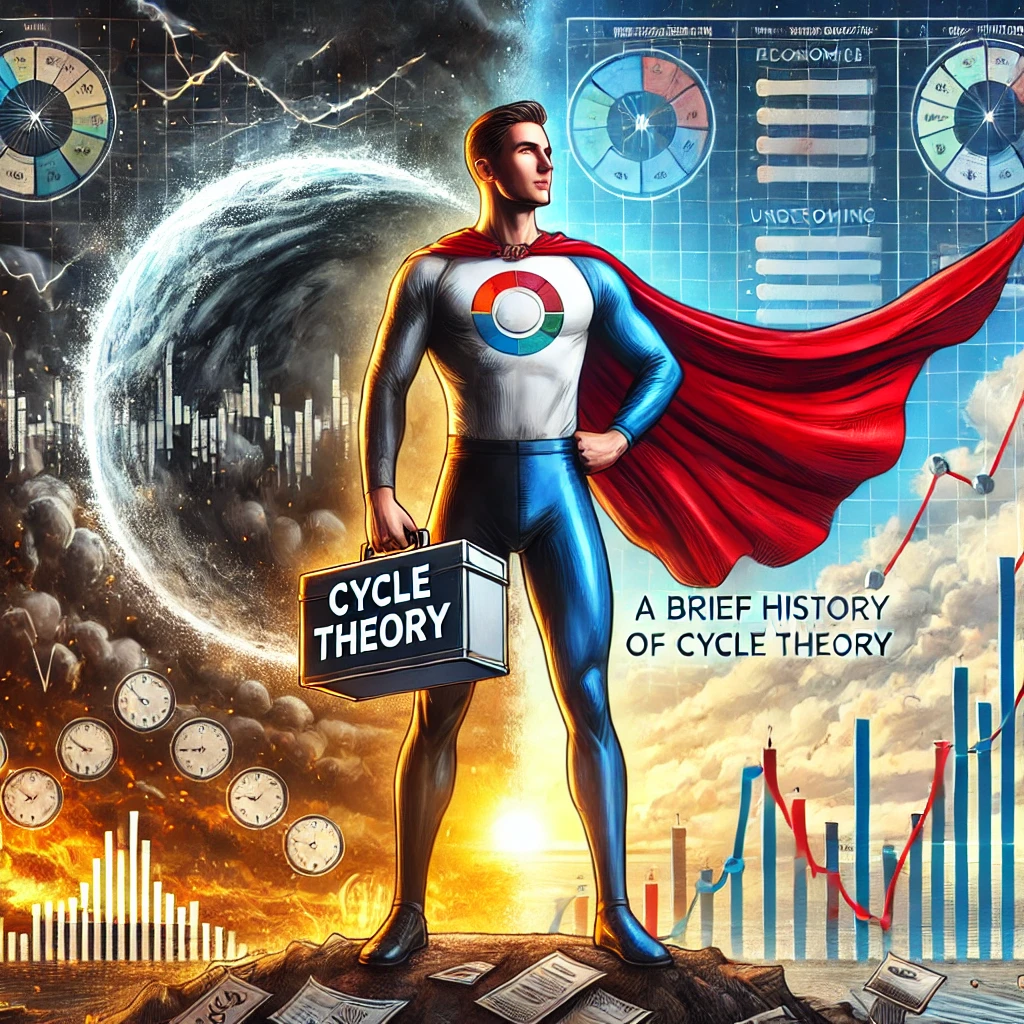
1. Introduction
Ever tried surfing? Imagine you’re out there, balancing on your board, eyes fixed on the horizon, searching for the perfect wave. The ocean’s rhythm has you feeling like a pro until—BAM!—a monster wave hits you out of nowhere. Suddenly, you’re tumbling, limbs flailing, questioning all your life choices.
Investing in the stock market? It’s eerily similar. One minute, you’re coasting along, your portfolio sparkling with potential. The next, a market crash leaves you dazed and scrambling to figure out what went wrong. Welcome to the wild ride of market cycles, where up is followed by down, then up again, over and over until your head spins like you’re on a rollercoaster.
Picture the stock market as a vast, unpredictable ocean of numbers and trends, full of waves of euphoria and troughs of despair. If only there were a way to navigate these cycles, to ride the waves with skill instead of flailing like a newbie. Enter Cycle Theory.
Cycle Theory is your backstage pass to the stock market. Think of it as a magical pair of X-ray glasses that unveil the hidden rhythms behind the chaotic dance of stocks, bonds, and other financial goodies. It’s the secret sauce that turns investment rookies into market wizards.
Now, I hear you: “Cycle Theory? Sounds dense and dull. Why not just stick with ‘buy low, sell high’ and cross my fingers?” Sure, you could. But if you’re reading this, you’re probably looking for more—a deeper understanding of the market’s ebb and flow, a way to decode the chaos. That’s exactly what we’ll explore.
In this post, we’ll plunge into Cycle Theory. We’ll break down what it is, why it matters, and how you can use it to become a smarter, more confident investor. We’ll dissect different types of cycles, from economic to sector-specific, and teach you to spot them. We’ll delve into the tools and techniques the pros use to analyze these cycles, spicing things up with real-world examples to bring the theory to life.
By the end, you’ll have a newfound respect for the market’s rhythms. You’ll be that surfer who not only rides the waves but also predicts their arrival. So grab your metaphorical surfboard, and let’s dive into the fascinating depths of Cycle Theory. Because once you decode the market’s cycles, investing becomes far more exhilarating—and far less like getting blindsided by a rogue wave.

2. The Importance of Cycle Theory in Financial Markets
Alright, strap in because we’re about to dive headfirst into the chaotic carnival ride that is the financial markets. Imagine yourself on a colossal roller coaster—the kind that flips your stomach, makes your heart race, and leaves your mind spinning with a mix of terror and thrill. The track twists, turns, and loops in ways you’d never expect. This is the perfect metaphor for financial markets—exhilarating, terrifying, and full of unexpected twists.
Now, let’s take it up a notch. Picture riding that roller coaster blindfolded. Terrifying, right? No clue when the next drop will come, no warning before you’re upside down, just hanging on for dear life. Navigating financial markets without understanding cycles feels just like that—chaotic, unpredictable, and nerve-wracking.
But what if you had a map of the roller coaster track? You’d know exactly when the steep drops and sharp turns were coming. Suddenly, the ride becomes less daunting and more manageable. That’s Cycle Theory in financial markets—a map through the madness.
Market Behavior: The Natural Rhythms of Chaos
First, let’s debunk a myth: markets aren’t random. They may seem like they’re driven by the erratic whims of a hyperactive squirrel, but there’s a method to this madness. Markets move in cycles, influenced by economic factors, investor psychology, and good old human nature.
Think of the market like a heartbeat. There’s a natural rhythm—periods of expansion followed by periods of contraction. Just like your heart, the market pulses with ups and downs, and understanding these rhythms can give you a significant edge.
Consider the dot-com bubble of the late ’90s—a classic expansion phase driven by irrational exuberance and speculative investing. The crash that followed in 2000? That’s the contraction phase where reality sets in, and the market corrects itself. The housing bubble of the mid-2000s and the financial crisis of 2008 followed the same pattern.
When you grasp that these cycles are intrinsic to market behavior, you start to see the bigger picture. Every boom is followed by a bust, and every bust by a recovery. It’s like watching a thriller where you already know the ending—the suspense is still there, but you’re not blindsided.
Investment Strategy: Riding the Waves Like a Pro
Why should you care about market cycles? Because aligning your investment strategy with these cycles can make you a smarter, more successful investor. Here’s how:
- Timing Your Investments: Imagine buying stocks at the peak of a bull market only to see their value nosedive during the subsequent crash. Ouch. By understanding the cycle, you can time your investments more effectively. Buy during the lows, sell during the highs—classic advice, but golden.
- Risk Management: Investing isn’t just about making money; it’s also about managing risk. Recognizing signs of an impending downturn allows you to adjust your portfolio conservatively, protecting your assets during rough patches. Conversely, during growth periods, you can afford to take on more risk.
- Strategic Allocation: Different assets perform variably through market cycles. During economic expansion, stocks tend to flourish, while during recessions, bonds might be safer. Understanding cycles helps you allocate assets strategically, maximizing returns while minimizing risk.
- Psychological Edge: Perhaps the most undervalued benefit of understanding market cycles is the psychological edge it provides. Investing can be an emotional roller coaster, but knowing the bigger picture helps you stay calm and rational. You won’t panic-sell during a downturn or get swept up in bubble euphoria.
Wrapping It All Up
Grasping cycles in financial markets is like having a roadmap for your investment journey. It helps you navigate the twists and turns, avoid pitfalls, and seize opportunities. It transforms the chaotic, unpredictable market into a series of patterns and rhythms that you can learn to recognize and ride.
In the end, mastering Cycle Theory is about embracing the market’s natural rhythms. It’s about becoming that savvy surfer who knows how to ride the waves, regardless of their size. So, next time you find yourself on the stock market’s roller coaster, remember: it’s not about avoiding the ride; it’s about knowing when to hold on tight and when to let go. Happy investing!

3. Types of Market Cycles
Alright, grab your popcorn and settle in, because we’re about to embark on a rollercoaster tour through the rock concert that is the financial market. Imagine yourself with a backstage pass, right in the midst of the headbanging crowd, where each cycle is a band belting out its greatest hits. We’ve got the timeless classics, the seasonal chart-toppers, and those funky niche genres that only the true aficionados know about. Ready? Let’s dive into this mosh pit.
Economic Cycles: The Market’s Rock Legends
First up on our lineup are the rock legends of the market cycle world: economic cycles. These are the headliners, the superstars that dominate the news with their epic performances and dazzling pyrotechnics. Think of them as the Beyoncé of market cycles—you just can’t ignore them, even if you tried.
Economic cycles are all about the grand narrative. They track the overall health of the economy, moving through four main stages: expansion, peak, recession, and recovery. Picture the economy as one massive, wild party. During expansion, everyone’s on the dance floor, drinks are flowing, and the DJ’s dropping hit after hit. When we hit the peak, the party’s at its absolute craziest—think confetti cannons and crowd surfing. But then comes the recession, the inevitable hangover, where the music dies down, and everyone’s regretting their life choices. Finally, recovery is the clean-up phase: you’re grabbing a greasy breakfast, nursing that hangover, and gearing up for the next big bash.
A classic example? The Roaring Twenties leading straight into the Great Depression—one massive party followed by a brutal hangover. Or the 2000s housing bubble bursting into the 2008 financial crisis. These cycles are driven by factors like consumer spending, business investments, and government policies. Understanding them is like knowing the setlist in advance—you can anticipate the highs and lows of the market performance.
Sector Cycles: The Indie Darlings
Next, let’s jam with the indie darlings of the market: sector cycles. These are like those beloved indie bands that might not always be in the mainstream spotlight but have a dedicated following nonetheless. Sector cycles focus on specific industries within the economy, each with its own unique rhythm.
Think of the tech sector as that unpredictable genius who suddenly drops a groundbreaking album and shakes up the entire industry. On the flip side, the healthcare sector is that steady, reliable artist who consistently delivers solid, if not always flashy, performances. Sector cycles often dance to their own beat, independent of the broader economic trends. For instance, the late ’90s tech boom was a sector-specific surge even when the overall economy was just cruising along. Getting a handle on sector cycles helps you make smarter investment choices, knowing which industries are rising stars and which ones are fading into obscurity.
Seasonal Cycles: The Festive Favorites
Now, let’s get into the holiday spirit with seasonal cycles. These are the festive hits that make a big splash at specific times of the year, like Mariah Carey’s “All I Want for Christmas Is You.” They’re predictable, dependable, and they pack a punch during their peak seasons.
Seasonal cycles are driven by recurring events. Picture retail stocks during the holiday season—sales skyrocket as shoppers flood the stores. Or agricultural stocks during planting and harvest seasons. Even tax season shakes things up as people adjust their portfolios to optimize returns. By tuning into these cycles, you can capitalize on predictable trends, making your investments not just profitable but also a bit more festive.
Market Sentiment Cycles: The Emotional Divas
Finally, we have the emotional divas of the market: sentiment cycles. These cycles are driven by the ever-changing moods of investors—fear, greed, optimism, and pessimism. Imagine the market as a soap opera, with sentiment cycles delivering the juicy plot twists that keep everyone on the edge of their seats.
When investors are feeling bullish, markets soar—everyone’s buying, prices are climbing, and euphoria sets in. It’s like a euphoric high where rationality takes a backseat. But then reality checks in, fear takes over, and the market plummets. It’s the panic phase, where everyone’s rushing to sell, driving prices even lower.
A prime example? The dot-com bubble. Investors were insanely optimistic about internet companies, driving stock prices to astronomical heights. But when the bubble burst, panic ensued, and the market came crashing down.
Wrapping It All Up
So, there you have it—the four types of market cycles, each with its own distinct beat and rhythm. Economic cycles are the big-picture headliners, sector cycles are the indie favorites, seasonal cycles are the festive hits, and market sentiment cycles are the dramatic divas that keep the market lively.
Understanding these cycles is like having an all-access pass to the financial market concert. You’ll know when to dance, when to take a breather, and when to brace yourself for the next big drop. Remember, no matter how wild the ride gets, every cycle eventually comes full circle. So keep your eyes and ears open, stay informed, and enjoy the show.

4. Identifying and Analyzing Cycles
Alright, maestro, we’ve waltzed through the various types of market cycles, and now it’s time to roll up our sleeves and get into the nitty-gritty: identifying and analyzing these cycles. Think of this as learning to read the sheet music of the financial symphony. Once you’ve mastered this, you’ll be spotting the market’s crescendos and diminuendos like a virtuoso.
Technical Indicators: The Market’s Musical Notation
First up, technical indicators. These are the market’s musical notes, guiding you when to amp up the volume, drop it low, or take a dramatic pause.
- Moving Averages: Imagine the moving average as the bass line in a track – it’s the underlying rhythm. A moving average smooths out the price data, creating a single, flowing line that reveals trends. You’ve got the simple moving average (SMA) and the exponential moving average (EMA), each with its own quirks. A 200-day moving average? Think long-term groove. A 50-day moving average? That’s your short-term beat.
- MACD (Moving Average Convergence Divergence): The MACD is your guitar solo – where things get interesting. It shows the relationship between two moving averages of a stock’s price. When the MACD line crosses above the signal line, it’s a guitar riff signaling an uptrend. Crosses below? A somber chord hinting at a downturn.
- RSI (Relative Strength Index): The RSI is your tempo marker, letting you know if the market’s overbought (playing too fast) or oversold (playing too slow). Ranging from 0 to 100, a reading above 70 suggests overbought territory, while below 30 indicates oversold.
Visual aids are your allies here. Picture this: a stock chart with the 200-day and 50-day moving averages plotted. The stock price is a roller coaster, but those moving averages? They’re the steady tracks, guiding you through the twists and turns. MACD and RSI? They’re the thrill-seeking loops and dips, indicating when the ride’s about to get wild.
Fundamental Analysis: The Lyrics Behind the Melody
Next, we’ve got fundamental analysis. If technical indicators are the notes, fundamental analysis provides the lyrics – the story behind the tune. Here’s where you delve into economic data, corporate earnings, and other fundamentals to understand the market’s narrative.
- Economic Data: Economic indicators like GDP growth, unemployment rates, and inflation are the verses giving context to the market’s chorus. Rising GDP might signal an expansion phase, while increasing unemployment could hint at a recession.
- Corporate Earnings Reports: These are like album reviews – they reveal how individual companies are performing. Strong earnings can boost stock prices, while disappointing results can tank them. Trends in earnings reports across sectors can offer clues about the market’s direction.
- Industry Trends: Keep an eye on industry-specific news and trends. Is a new technology shaking up a sector? Are regulatory changes impacting certain industries? These plot twists can dramatically alter market cycles.
Think of yourself as a detective piecing together clues from various sources. Economic reports, earnings data, industry news – they all come together to form a coherent story about where the market is and where it might be headed.
Sentiment Analysis: The Audience’s Reaction
Finally, let’s talk about sentiment analysis. This is the crowd’s reaction at a concert – are they cheering, booing, or somewhere in between? Investor sentiment can be a powerful indicator of market cycles.
- News and Media: Media coverage is like the pre-concert hype. Is the press optimistic or pessimistic about the market? Positive news can drive bullish sentiment, while negative coverage can spark fear and sell-offs.
- Social Media and Forums: Platforms like Twitter, Reddit, and financial forums are today’s rumor mills. Gauging the crowd’s mood here can indicate whether investors are feeling euphoric or anxious. Remember GameStop? That was a sentiment-driven roller coaster.
- Investor Surveys: Surveys like the AAII Sentiment Survey offer snapshots of investor sentiment. Bullish, bearish, or somewhere in between? This data provides insights into potential market moves.
Think of sentiment analysis as reading the room. Whether you’re at a rock concert or in the stock market, understanding the crowd’s mood helps you anticipate the next big move.
Putting It All Together: The Symphony of Analysis
So, how do you weave all these elements together? Think of yourself as the conductor of a financial symphony. Technical indicators are your sheet music, fundamental analysis provides the lyrics, and sentiment analysis captures the audience’s reaction. By harmonizing these elements, you create a cohesive understanding of market cycles.
Imagine analyzing a stock like composing a symphony. Start with the steady rhythm of moving averages, add the dramatic solos of MACD and RSI, weave in the lyrical context of economic and corporate fundamentals, and capture the crowd’s reaction with sentiment analysis. The result? A masterpiece of market insight, guiding you through the financial concert with finesse.
Master these techniques, and you’ll spot the market’s subtle shifts and grand crescendos. So grab your baton, step up to the podium, and get ready to conduct the financial symphony of your life.

5. Applying Cycle Theory to Investing
Alright, you’ve waded through the dry-as-dust theory, indulged in the technical complexities, and now you’ve got a pretty solid grip on the market’s symphony. Time to transition from the classroom to the battlefield and turn all this knowledge into some serious financial gains. Let’s dive into how Cycle Theory can be your secret weapon in the investing game. Think of this as strapping on your superhero cape and wielding your newfound powers to take on the financial universe.
Developing a Strategy: Crafting Your Master Plan
First order of business: crafting a strategy. But before you dive in headfirst, let’s chart out a roadmap. Imagine planning a cross-country road trip – you wouldn’t just jump in the car and start driving (unless you thrive on chaos). You’d map out your journey, plan your pit stops, and stock up on essentials. Investing demands the same meticulous planning.
- Identify the Cycle Stage:
- Start by pinpointing our location in the cycle. Are we soaring through an expansion phase, buoyed by economic growth and optimism? Or are we weathering a recession, with everyone scrambling for safety? Use your technical indicators, fundamental analysis, and sentiment readings to determine the current stage.
- Set Your Goals:
- What are your investment aspirations? Are you in it for long-term growth, short-term profits, or a mix of both? Your objectives will shape your strategy. Long-term players might ride out the cycles, while those seeking quick gains need to be agile and responsive to market shifts.
- Choose Your Instruments:
- Different cycle stages call for different investments. In an expansion, stocks and high-yield bonds might be your allies. In a recession, defensive assets like gold, utilities, or government bonds become your safe havens. It’s like picking the right vehicle for your road trip – you wouldn’t take a convertible off-roading, nor would you invest in speculative tech stocks during a market crash.
Case Studies: Learning from the Masters
Let’s animate this theory with some real-world case studies. Imagine you’re a detective piecing together a puzzle, but instead of solving a crime, you’re uncovering the secrets of successful investments. Here are a couple of noteworthy examples:
- The 2008 Financial Crisis:
- Recall the housing bubble that burst and plunged the global economy into chaos? Investors versed in Cycle Theory saw the red flags – exorbitant home prices, rampant speculation, and risky subprime lending. Shrewd investors shifted their money into safer assets like treasury bonds and gold. When the market bottomed out, they snapped up undervalued stocks at rock-bottom prices, positioning themselves for substantial gains during the subsequent recovery.
- The Dot-Com Bubble:
- Ah, the late ’90s, when everyone was investing in internet startups with no tangible business models. The bubble burst in 2000, erasing trillions in market value. But astute investors who recognized the bubble cashed out before the crash. They bided their time and re-entered the market once the dust settled, buying solid tech companies at a fraction of their former prices.
Tools and Resources: Your Financial Swiss Army Knife
Now that you’ve got a strategy and some inspiration, let’s talk tools. Just like a Swiss Army knife, you need a variety of tools to navigate the market’s complexities. And guess what? PrimeIQ Labs has you covered with some top-tier resources.
- PIQL Pro:
- Our proprietary tool, PIQL Pro, acts like a financial GPS, guiding you through market cycles. It leverages advanced algorithms and real-time data to help you identify cycle stages, analyze trends, and make informed investment decisions. Think of it as your co-pilot on this investing journey.
- Educational Resources:
- Knowledge is your greatest ally. Dive into our extensive library of articles, webinars, and tutorials that distill complex concepts into digestible nuggets of wisdom. Whether you’re a novice or a seasoned pro, there’s always something new to learn.
- Community Support:
- Join our community of like-minded investors. Share insights, ask questions, and learn from the collective wisdom of the group. Investing doesn’t have to be a solitary endeavor – it’s like a potluck where everyone brings something valuable to the table.
Challenges and Limitations: Navigating the Rough Patches
But it’s not all smooth sailing. Investing based on Cycle Theory has its challenges. It’s akin to being a weather forecaster – even with all the data, you can’t predict every storm.
- Predicting Cycles:
- One of the biggest hurdles is accurately predicting cycles. Even the experts get it wrong sometimes. The key is to stay flexible and adapt your strategy as new information emerges. Don’t hesitate to pivot if the market throws you a curveball.
- Market Anomalies:
- Sometimes, the market defies expectations. Black swan events, geopolitical tensions, and unforeseen economic shifts can disrupt your plans. Stay informed, stay vigilant, and always have a contingency plan.
The Future of Cycle Theory: The Road Ahead
Looking forward, the future of Cycle Theory is promising. Advances in technology, like AI and machine learning, are making it easier than ever to analyze market data and predict cycles. Neural networks, for example, can detect patterns and trends that might elude human analysts, providing you with a cutting-edge advantage.
Global economic shifts and new financial instruments are also transforming the landscape. Staying ahead of these trends will be crucial to mastering Cycle Theory.
Conclusion: Becoming a Market Maestro
Applying Cycle Theory to investing is akin to conducting a symphony. It requires skill, knowledge, and a touch of intuition. But with the right strategy, tools, and mindset, you can navigate the market’s ups and downs with confidence and poise.
So go ahead, don your superhero cape, grab your Swiss Army knife, and step into the financial arena. With Cycle Theory as your guide, you’re poised to conquer the market’s wild ride. Happy investing!

6. Challenges and Limitations
Alright, so you’ve armed yourself with the Cycle Theory toolkit, feeling like a financial superhero ready to conquer the markets. But before you don your cape and leap into the fray, let’s have a heart-to-heart about the not-so-glamorous side of Cycle Theory. Think of it as the dark side of the moon—it’s there, even if you’d prefer not to acknowledge it. But grasping these challenges is crucial because no theory, no matter how shiny, is without its shadows.
Predicting Cycles: The Crystal Ball Conundrum
First up, the big one: predicting cycles is tough. Really tough. Imagine trying to forecast the weather a year ahead—you can make an educated guess based on patterns and data, but the multitude of variables means your prediction is likely to miss the mark.
The same goes for market cycles. Sure, we have heaps of data, fancy algorithms, and advanced analytics tools. But the market is swayed by a dizzying array of factors: economic indicators, political events, natural disasters, technological shifts, investor psychology, and sometimes sheer randomness. It’s like trying to play 4D chess with a hyperactive squirrel. Even the best investors get it wrong sometimes, and that’s okay. The trick is to stay flexible and be ready to pivot when new information surfaces.
Market Anomalies: When the Unexpected Strikes
Next up, market anomalies—the financial world’s surprise parties. Sometimes delightful, often disruptive, and always unexpected. Market anomalies are those outlier events that don’t fit neatly into our cycle theories. Think black swan events like the 2008 financial crisis or the COVID-19 pandemic. These events can derail even the most meticulous plans.
Anomalies are, by definition, hard to predict. They appear out of nowhere and wreak havoc on the markets. So what’s an investor to do? Build a resilient portfolio that can weather these storms. Diversification is your ally here. Spread your investments across different asset classes, sectors, and geographies to minimize the impact of any single anomaly. It’s like having multiple safety nets—if one fails, you’ve got others to catch you.
Human Emotions: The Unruly Wild Card
And then there’s the wild card: human emotions. If the market is a roller coaster, investor sentiment is the unpredictable weather that can turn a smooth ride into a heart-pounding adventure. Fear, greed, optimism, and panic drive market movements in ways that are impossible to predict with precision.
Remember the dot-com bubble? Investors were so swept up in the euphoria of the internet boom that they ignored all the warning signs. When reality hit, the crash was brutal. Or take the 2008 financial crisis—fear and panic led to a massive sell-off, exacerbating the downturn. Emotions can amplify market cycles, making peaks higher and troughs deeper.
So how do you manage this unruly beast? Stay informed and maintain a long-term perspective. Don’t get caught up in the daily noise of the market. Stick to your strategy, stay disciplined, and remember that market cycles are a natural part of investing. A little mindfulness and emotional intelligence can go a long way in keeping your cool when everyone else is losing theirs.
Technological Limitations: The Data Dilemma
We live in an era where data reigns supreme. But having access to mountains of data isn’t the same as knowing what to do with it. Our advanced tools and algorithms are only as good as the data we feed them. And here’s the kicker: not all data is created equal. Poor-quality data, incomplete datasets, and biases can all lead to flawed analyses and predictions.
Moreover, technologies like AI and machine learning, while powerful, are not infallible. They can identify patterns and trends that humans might miss, but they can also overfit models to past data, leading to inaccurate predictions for the future. It’s the classic “garbage in, garbage out” problem. Always question your data sources, validate your models, and remember that technology is a tool, not a magic wand.
Economic and Political Factors: The Moving Targets
Finally, let’s talk about the ever-shifting landscape of economic and political factors. Governments change, policies evolve, and global events can reshape the market landscape overnight. Trade wars, regulatory changes, and geopolitical tensions are just a few examples of factors that can disrupt market cycles.
These factors are often beyond our control, but we can stay informed and be proactive. Keep an eye on the news, understand the potential impacts of major events, and be ready to adjust your strategy as needed. Flexibility and adaptability are key—think of yourself as a financial ninja, ready to pivot and strike when the situation demands.
Wrapping It All Up
So there you have it—the dark side of Cycle Theory. Predicting market cycles is more art than science, and there are plenty of challenges and limitations to keep you on your toes. But don’t let that discourage you. By understanding these pitfalls and preparing for them, you can become a more resilient and informed investor.
Remember, the goal isn’t to predict the future with perfect accuracy—it’s to make educated decisions, stay flexible, and manage risk effectively. Think of Cycle Theory as a powerful tool in your investing arsenal, but not the only one. Combine it with other strategies, stay informed, and always be ready to adapt. Because in the end, it’s not about avoiding the storms—it’s about learning to dance in the rain. Happy investing!

7. The Future of Cycle Theory
Alright, fellow market adventurers, buckle up. We’ve navigated the intricate waltz of market cycles, learned to spot them with the finesse of a seasoned detective, and faced their challenges head-on. Now, let’s grab our crystal ball, and gaze into the kaleidoscopic future of Cycle Theory. Spoiler alert: it’s going to be a wild, tech-infused ride.
Technological Advancements: The Rise of the Machines
Imagine Cycle Theory as our trusty hero, suddenly imbued with superpowers by the dazzling wonders of technology. AI and machine learning aren’t just enhancing our analysis; they’re turning it into a predictive powerhouse. Picture this: neural networks crunching through terabytes of data faster than you can say “market volatility,” unearthing patterns mere mortals could never detect.
Visualize these algorithms processing everything from historical price data to social media sentiment, then spitting out eerily accurate market forecasts. It’s like having a digital oracle whispering in your ear. But here’s the kicker: these tech marvels are constantly learning, adapting, and getting sharper. It’s akin to having a personal financial assistant who gets smarter with every passing day. As AI continues its relentless march forward, expect our predictive tools to become even more precise and action-ready.
Big Data: The New Gold Rush
Let’s dive into the swirling ocean of Big Data. We’re living in an age where every tweet, every purchase, every click leaves a trail of digital breadcrumbs. This data deluge is a veritable goldmine for investors. With Big Data, we can glean insights into market cycles that were once the stuff of fantasy.
Consider this: real-time tracking of consumer behavior, monitoring global economic indicators, and gauging investor sentiment all become second nature. This torrent of information unveils the market’s ebbs and flows with a clarity that’s nothing short of high-definition. Future advancements in data analytics will sift through the noise to reveal hidden signals and trends, giving investors a decisive edge. It’s the difference between navigating with a compass and a GPS—one offers a rough idea, the other provides pinpoint precision.
Global Connectivity: The World at Your Fingertips
Next up, the increasing interconnectedness of global markets. Technology has knitted the world into a web of instant information flow. Events in one corner of the globe now ripple through markets worldwide at the speed of light.
This global connectivity is a double-edged sword. It means market cycles are influenced by a complex web of geopolitical events, international trade, and even cultural trends. But it also means we have a treasure trove of global data at our fingertips. Savvy investors will leverage this interconnectedness to their advantage, staying attuned to international markets and understanding the intricate dance of global economies. It’s like playing chess on a worldwide board, where every move is interconnected.
Sustainability and ESG: The New Frontier
Now, let’s turn our gaze to the rising stars of sustainability and ESG (Environmental, Social, and Governance) factors. Investors are increasingly recognizing the crucial role these factors play in shaping market cycles. Companies prioritizing sustainability and strong governance often weather economic storms better and seize growth opportunities with aplomb.
As the world shifts towards sustainable practices, ESG factors will become integral to Cycle Theory. Investors will analyze how companies and sectors adapt to environmental challenges, social changes, and regulatory pressures. It’s like adding a green lens to your financial analysis—not just about profits, but about sustainable, long-term growth.
Human-Machine Collaboration: The Dream Team
Finally, let’s celebrate the ultimate power duo: humans and machines. While AI and Big Data are transforming the landscape, human intuition and experience remain irreplaceable. The future of Cycle Theory lies in the seamless collaboration between human analysts and machine algorithms.
Imagine a world where AI handles the heavy lifting of data analysis, while humans provide the context, creativity, and strategic thinking. Machines identify patterns and trends with pinpoint accuracy, but humans interpret these insights, ask the right questions, and make nuanced decisions. It’s the best of both worlds—the analytical prowess of machines combined with the wisdom and judgment of humans.
Wrapping It All Up
So, what does the future hold for Cycle Theory? In a word: evolution. Technological advancements, Big Data, global connectivity, sustainability, and human-machine collaboration are all shaping our understanding and application of Cycle Theory. It’s an exhilarating time to be an investor, with new tools and insights transforming the landscape.
Yet, no matter how advanced our tools become, the core principles of Cycle Theory remain steadfast. Markets will always move in cycles, driven by a complex interplay of economic factors, investor sentiment, and global events. Our mission is to stay informed, adaptable, and ready to use every tool at our disposal to navigate these cycles with confidence and skill.
So gear up, embrace the future, and get ready to ride the market waves with newfound power and precision. The future of Cycle Theory is bright, and the adventure is just beginning. Happy investing!

8. Wrapping It Up
Ladies and gentlemen, we’ve ventured deep into the intricate realm of Cycle Theory, and what an odyssey it has been. We’ve explored the rhythmic ballet of economic cycles, the dramatic flair of sector cycles, the reliable cadence of seasonal cycles, and the emotional crescendo of market sentiment cycles. We’ve equipped ourselves with the tools to decipher and navigate these cycles, tackled challenges head-on, and even gazed into the future’s possibilities. But now, as we draw this epic journey to a close, let’s pause to see the grand panorama.
Riding the Waves
Imagine the market as a vast ocean—powerful, majestic, and occasionally unpredictable. Just as surfers master the waves, investors can learn to maneuver through these cycles. It’s not about battling the current; it’s about understanding it, respecting it, and harnessing it to your advantage.
Cycle Theory is your surfboard, guiding you through the tumultuous waters of financial markets. It enables you to anticipate the big waves, allowing you to ride them with confidence instead of being overwhelmed. While it’s not a crystal ball that predicts the future with flawless accuracy, it’s a potent tool that offers a profound understanding of the market’s intrinsic rhythms.
The Power of Insight
Knowledge is a formidable force. By mastering Cycle Theory, you’re arming yourself with a superpower that distinguishes you from the average investor. You’re not merely reacting to market movements; you’re anticipating them, preparing for them, and leveraging them to your benefit. You become the surfer who intuitively knows when to paddle out and when to ride the wave back to shore.
But don’t stop here. The world of investing is expansive and ever-evolving. Continue learning, questioning, and exploring. Delve into new theories, experiment with fresh strategies, and stay inquisitive. The more you know, the better equipped you’ll be to navigate the market’s complexities.
Flexibility and Adaptability
One of the crucial lessons from Cycle Theory is the importance of flexibility and adaptability. The market is like a wild stallion—untamable, but learnable. Be ready to adjust your strategy as new information emerges. Stay flexible, remain open-minded, and don’t hesitate to pivot when circumstances demand it.
Consider yourself a financial ninja—swift, agile, and perpetually ready to adapt. Whether you’re confronted with a market anomaly, a sudden economic shift, or an unexpected geopolitical event, your adaptability will be your greatest asset. Embrace the uncertainty and turn it to your advantage.
The Human Element
Let’s not overlook the human element. Despite all the sophisticated tools and advanced algorithms, investing remains a profoundly human endeavor. Emotions, psychology, and behavior significantly influence market movements. Understanding these human factors is as crucial as analyzing the data.
Cultivate emotional intelligence and mindfulness. Stay composed in the face of market turbulence and avoid letting fear or greed dictate your decisions. Remember, the best investors are not just adept at number-crunching; they’re also keen observers of human nature. They recognize that behind every market move lies a story of human behavior.
Your Journey Ahead
As you continue on your investing journey, internalize these lessons. Use Cycle Theory as your guide, but don’t hesitate to carve your own path. Stay curious, remain adaptable, and keep the human touch. The market is a grand adventure, filled with opportunities and challenges. Embrace it with confidence, and remember that each cycle brings new possibilities.
So, don your superhero cape, grab your financial surfboard, and dive into the thrilling world of investing. With the wisdom of Cycle Theory in your arsenal, you’re ready to ride the waves, weather the storms, and conquer the financial seas. Happy investing, and may the cycles always be in your favor!

9. Appendices
Appendix A: Glossary of Terms
Before you sprint off, armed with the secrets of Cycle Theory, let’s make sure your financial vocabulary is as sharp as a Wall Street analyst’s pencil. Think of this glossary as your Rosetta Stone for decoding market jargon. Ready? Let’s dive headfirst into the financial lingo pool.
- Cycle Theory: The superhero cape of our story, Cycle Theory is about spotting those sneaky recurring patterns in financial markets. It’s your crystal ball, helping you predict changes and make decisions that would make even Nostradamus jealous.
- Economic Cycles: The grand rollercoaster ride of the economy, with four thrilling stages: expansion (the ‘woohoo!’ growth phase), peak (the dizzying summit), recession (the ‘uh-oh’ decline), and recovery (the ‘phew!’ rebound).
- Sector Cycles: Each industry dances to its own rhythm. Tech, healthcare, finance—they all have their unique cycles. Knowing these can help you groove to the beat of profitable investing.
- Seasonal Cycles: The holiday hits of the market. These are predictable trends tied to the calendar, like retail stocks booming during the festive season.
- Market Sentiment Cycles: The emotional rollercoaster driven by investor psychology. Fear, greed, optimism, panic—these cycles are all about the collective mood swings of the market.
- Technical Indicators: The sheet music of market analysis—tools like moving averages, MACD, and RSI that help you spot trends and cycles.
- Fundamental Analysis: The lyrics to our market melody. This involves examining economic data, corporate earnings, and industry trends to understand the market’s underlying story.
- Big Data: The new gold rush. It’s the massive amount of data generated every second, from social media to transaction records, analyzed to uncover market insights.
- AI and Machine Learning: The rise of the machines. These technologies sift through vast amounts of data to detect patterns and make predictions, transforming how we apply Cycle Theory.
- Diversification: The smart investor’s strategy of not putting all their eggs in one basket. Spreading investments across various assets to minimize risk.
Appendix B: Additional Resources
Because knowledge is your most powerful tool, and you’re on a quest to become a market maestro, here are some resources to further your understanding of Cycle Theory and investing. Think of these as treasure maps guiding you to financial enlightenment.
Books to Devour:
- “Irrational Exuberance” by Robert J. Shiller: Dive deep into the psychology of market cycles and how emotions drive economic booms and busts.
- “The Intelligent Investor” by Benjamin Graham: A timeless guide to value investing, offering wisdom on market behavior and investment strategies.
- “A Random Walk Down Wall Street” by Burton G. Malkiel: An engaging exploration of market theory, questioning the predictability of market movements.
Websites to Bookmark:
- Investopedia: Your go-to resource for all things investing, from definitions to in-depth articles on market trends and strategies.
- Seeking Alpha: A wealth of investment analysis, news, and insights from a community of investors and experts.
- Bloomberg: Stay updated with the latest financial news, data, and analysis from one of the world’s leading financial news organizations.
Communities to Join:
- PrimeIQ Labs Community: Connect with fellow investors, share insights, ask questions, and learn from the collective wisdom of the group.
- r/Investing on Reddit: A vibrant community of investors discussing everything from market trends to investment strategies.
- Twitter Finance Community: Follow key influencers, analysts, and financial experts for real-time insights and market commentary.
Podcasts to Tune In To:
- “The Indicator from Planet Money”: Bite-sized episodes exploring economic trends, market movements, and investing strategies.
- “We Study Billionaires”: Interviews with some of the world’s most successful investors, offering insights into their strategies and thought processes.
- “Animal Spirits”: A fun and informative podcast discussing market trends, investing, and financial planning.
Wrapping It All Up
So there you have it, the appendices to your Cycle Theory masterclass. With this glossary, these resources, and your insatiable curiosity, you’re well on your way to becoming a market virtuoso. Remember, investing is a journey, not a destination. Keep learning, stay curious, and embrace the ride. The financial world is your oyster—go ahead and crack it open! Happy investing!

I do agree with all the ideas you have introduced on your post They are very convincing and will definitely work Still the posts are very short for newbies May just you please prolong them a little from subsequent time Thank you for the post
Thank you for the good writeup. It in fact was a amusement account it. Look advanced to far added agreeable from you! However, how could we communicate?